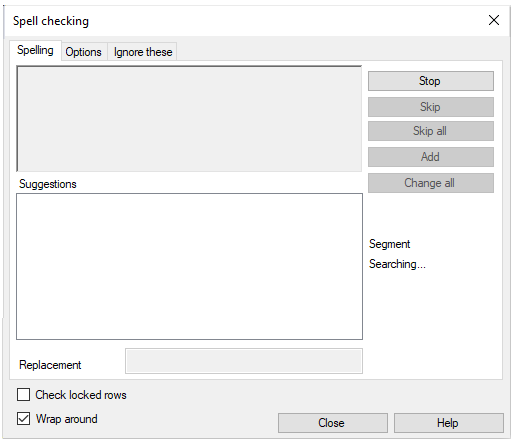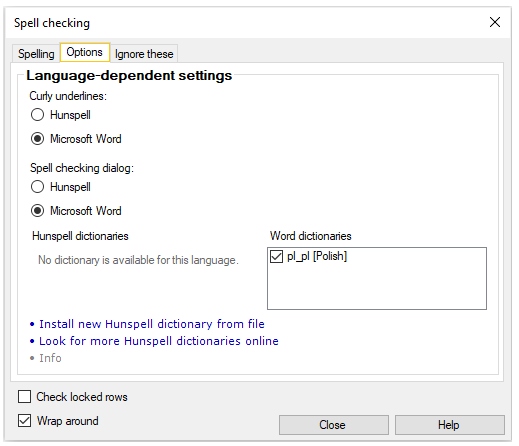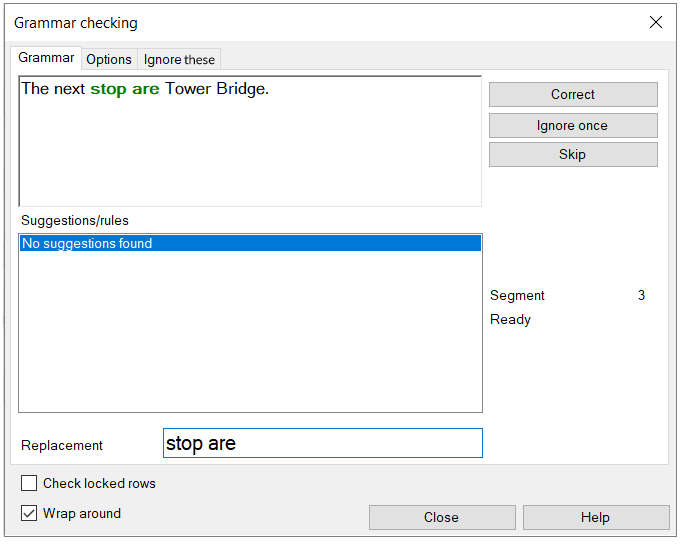Spell checking/Grammar checking
Before you deliver a translation, you are supposed to check its spelling (and grammar).
memoQ uses either Microsoft Word's spelling and grammar checker, or Hunspell (an open-source spell checker). To use Word's spelling and grammar, you need to have Word installed on your computer – together with the language pack for your memoQ project's target language.
Normally, in the Grid memoQ underlines supposed spelling errors with red, and grammar errors with blue. To correct an error, right-click the underlined word or sentence, and choose a suggestion from the menu (you can also edit the text manually).
You need the Spell checking window only if you want to go through all spelling and grammar warnings in one go. You should do this before delivering the translation.
Set up spell checking first: To do that, open Options ![]() , and choose the Spelling and grammar item from the Category list.
, and choose the Spelling and grammar item from the Category list.
Spell check runs grammar, too: If Microsoft Word is on your computer, and it has the grammar checker for your target language, memoQ will show grammar problems in the same window - unless you turn it off in the Options ![]() window (Spelling and Grammar pane, Grammar tab).
window (Spelling and Grammar pane, Grammar tab).
Copyright Notice for Hunspell
Hunspell Spelling Checker
memoQ © memoQ Zrt. All rights reserved.
memoQ prefers Hunspell as the alternative spelling checker. Installed as separate program.
© 2003–2008 László Németh; FSF.hu Foundation. Licensed under GPL/LGPL/MPL tri-license.
How to get here
- Open a project.
- Open a document for editing.
- On the Translation ribbon, click Spelling/Grammar
 . Or, press F7.
. Or, press F7. -
The Spell checking window opens. It keeps you waiting until it finds the first spelling error.

What can you do?
Check spelling
Go through the spelling errors in the document, and decide what to do about each.
In the Spell Checking window memoQ marks spelling errors in red, and in the Grammar Checking window, it marks grammar errors in green. Grammar errors will show only if Microsoft Word is installed on the computer, and it has the grammar checker for your target language.
When memoQ stops at an error, choose one of the following:
-
Correct the error just this once: From the Suggestions list, choose a suggestion, or type the correction in the Replacement box. Click Correct.
-
Correct the error everywhere in the document: From the Suggestions list, choose a suggestion, or type the correction in the Replacement box. Click Change all.
-
Ignore the error just this once: Click Skip.
-
Ignore the same error everywhere in the document: Click Skip All.
-
Tell memoQ that this is not a spelling error: Click Add to add this term to an ignore list.

If you start spell checking in the middle of a document, memoQ will start over at the end. To turn this off, clear the Wrap around checkbox in the bottom left corner of the window.
Normally, memoQ does not check locked rows: To check them, select the Check locked rows checkbox in the bottom left corner of the window.
It is not for all languages: There is no spell checking for Japanese, Chinese, and Korean. Also, for Vietnamese and Thai, spell checking is not supported. For these languages, use the grammar checker.
You can set up the spell checker and change its settings in the Spell checking window. To do that, click the Options tab.

The settings are the same as on the Spelling and grammar pane of the Options ![]() window. (You cannot choose the language here – this window works for the current target language.)
window. (You cannot choose the language here – this window works for the current target language.)
To learn more about language-dependent settings: See the documentation for the Spelling and grammar pane in Options.
When you click Add to tell memoQ that a word is correct, memoQ adds it to an ignore list. To do this, you need an ignore list first.
Ignore lists are resources that you can also create and edit in the Resource console ![]() .
.
To manage ignore lists in the Spell checking window, click the Ignore these tab.

Here you can:
-
Create a new ignore list: Click New. The Create new ignore list window opens.
-
Edit an ignore list: Select the ignore list you want to modify. Click Edit. The Edit ignore list window opens.
-
Delete an ignore list: Uncheck the ignore list you want to delete. Click Delete. To confirm your action, click Yes in the Confirm delete window. You can delete only one ignore list at once.
-
Tell memoQ where to add new words in the project: From the In the current project, add new words to drop-down box, choose the ignore list you want to use. Make sure to check all lists in the Ignore lists box you want to see in the drop-down.
-
Tell memoQ to also look for words in the project's non-translatable lists when checking spelling: Normally memoQ ignores phrases in those non-translatable lists. To change this behavior, clear the Ignore items in the non-translatable lists added to the project checkbox.
Check grammar
After spell checking finishes, the Grammar checking window opens:

In the Spell Checking window memoQ marks spelling errors in red, and in the Grammar Checking window, it marks grammar errors in green. Grammar errors will show only if Microsoft Word is installed on the computer, and it has the grammar checker for your target language.
When memoQ stops at an error, choose one of the following:
-
Correct the error: From the Suggestions/rules list, choose a suggestion, or type the correction in the Replacement box. Click Correct.
-
Mark found error as correct and continue: Click the Ignore once button.
-
Leave this finding marked as an error and continue: Click the Skip button.
When you finish
If you want to return to the translation editor: Click Close.